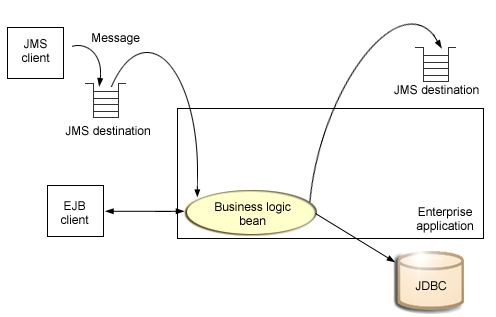Overview of JMS
WAS supports asynchronous messaging as a method of communication based on the Java Message Service (JMS) programming interface. JMS provides a common way for Java programs (clients and J2EE applications) to create, send, receive, and read asynchronous requests, as JMS messages.
This topic provides an overview of asynchronous messaging using JMS support provided by WAS. For more details about JMS, see the following Web sites:
The base support for asynchronous messaging using JMS provides the common set of JMS interfaces and associated semantics that define how a JMS client can access the facilities of a JMS provider. This enables WebSphere J2EE applications, as JMS clients, to exchange messages asynchronously with other JMS clients by using JMS destinations (queues or topics). An J2EE application can use JMS queue destinations for point-to-point messaging and JMS topic destinations for publish/subscribe messaging. An J2EE application can explicitly poll for messages on a destination then retrieve messages for processing by business logic beans (enterprise beans).

Asynchronous messaging using JMS
The preceding figure shows an enterprise application polling a JMS destination to retrieve an incoming message, which it processes with a business logic bean. The business logic bean uses standard JMS calls to process the message; for example, to extract data or to send the message on to another JMS destination. For more information, see the text that accompanies this figure.With the base JMS/XA support, the J2EE application uses standard JMS calls to process messages, including any responses or outbound messaging. Responses can be handled by an enterprise bean acting as a sender bean, or handled in the enterprise bean that receives the incoming messages. Optionally, this process can use two-phase commit within the scope of a transaction. This level of functionality for asynchronous messaging is called bean-managed messaging, and gives an enterprise bean complete control over the messaging infrastructure; for example, for connection and session pool management. The application server has no role in bean-managed messaging.
WAS also supports automatic asynchronous messaging using message-driven beans (a type of enterprise bean defined in the EJB 2.0 specification) and JMS listeners (part of the JMS application server facilities). Messages are automatically retrieved from JMS destinations, optionally within a transaction, then sent to the message-driven bean in an J2EE application, without the application having to explicitly poll JMS destinations. For more information about asynchronous messaging with message-driven beans, see An overview of message-driven beans.
For more overview information, see these topics:
JMS - components
This topic describes the main components of WAS support for JMS.JMS - connection pooling
This topic describes the support of WebSphere MQ JMS connection pooling.